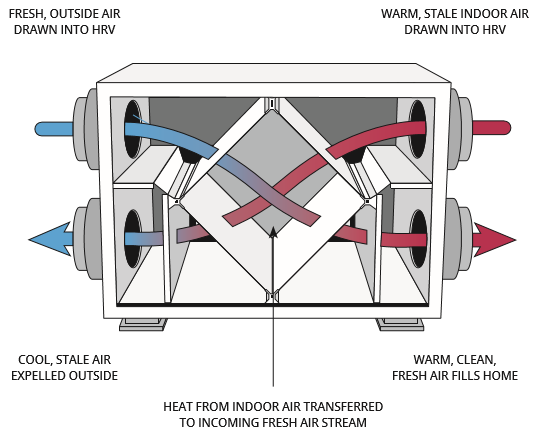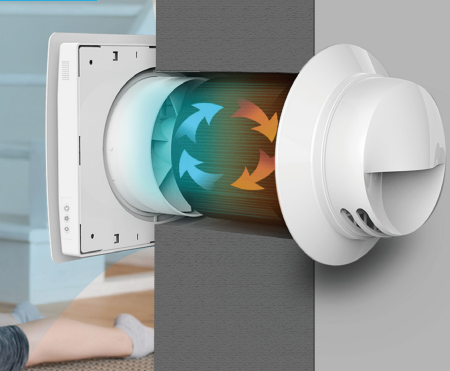The Environmental Impact of HRV in Modern Homes
Exactly How Heat Recovery Ventilation Enhances Indoor Air High Quality and Reduces Energy Costs
Heat Recovery Ventilation (HRV) systems play a necessary function in enhancing indoor air quality while at the same time reducing power expenditures. By successfully exchanging stale indoor air with fresh exterior air, HRVs help keep ideal moisture and decrease toxins. Additionally, their capability to recoup heat from outgoing air lessens the pressure on heating and cooling down systems. As power costs remain to rise, recognizing the full possibility of HRV systems ends up being progressively essential for property owners and companies alike.
Understanding Heat Recovery Ventilation Solutions

Heat recovery ventilation (HRV) systems play a crucial role in improving interior air quality, especially in modern-day, energy-efficient structures. These systems are designed to transfer heat from the outbound stagnant air to the inbound fresh air, therefore reducing energy loss while preserving suitable temperature degrees indoors. HRVs are composed of a heat exchanger, fans, and ductwork, assisting in the constant flow of air. By getting rid of interior contaminants and introducing fresh air, HRVs aid to balance moisture degrees, protect against mold and mildew development, and minimize irritants. The performance of HRV systems depends on their ability to recover as much as 80% of the heat from the tired air, promoting energy preservation while making certain a healthy and balanced interior setting. Their assimilation is crucial in attaining lasting living methods.
The Significance of Indoor Air Quality
Indoor air quality (IAQ) is a crucial element affecting the health and wellness of passengers in any kind of environment. Poor IAQ can result in various wellness issues, consisting of respiratory problems, allergic reactions, and tiredness. Additionally, it can worsen status quo such as bronchial asthma. Elements adding to reduced IAQ include contaminants from indoor resources like cleaning up agents, mold, and inadequate ventilation. Consequently, keeping good IAQ is essential for promoting a safe and comfy living or working room. Efficient approaches to enhance IAQ include regular monitoring of air quality, proper air flow systems, and reducing using dangerous substances inside your home. By prioritizing IAQ, individuals can assure a healthier atmosphere that cultivates efficiency and general lifestyle.
Power Efficiency Advantages of HRV Solutions
Lots of home owners and building managers are increasingly acknowledging the energy effectiveness benefits of warm healing air flow (HRV) systems. By transferring warmth from exhausted interior air to incoming fresh air, HRV systems markedly reduce the energy needed for cooling and heating. This procedure decreases dependence on traditional a/c systems, bring about reduced energy costs. Furthermore, HRVs aid maintain a balanced interior environment, protecting against excessive heating or cooling down needs. The capability to recover approximately 90% of the heat from outgoing air also supports sustainability initiatives by reducing general power usage. HRV systems add not only to cost financial savings however additionally to a lowered carbon impact, lining up with the growing focus on energy-efficient structure techniques.
Setup and Maintenance Considerations
The efficient application of warmth recuperation ventilation (HRV) systems calls for cautious factor to consider of installation and upkeep variables to guarantee peak efficiency. Appropriate positioning of the HRV unit is vital, as it needs to be set up in an area that maximizes air movement while minimizing noise disruption. Furthermore, ductwork has to be suitably sized and insulated to avoid energy loss. Regular upkeep, including filter substitute and system cleaning, is critical to secure ideal performance and interior air high quality. Proprietors should establish a routine maintenance schedule to identify and resolve potential concerns prior to they intensify. Collaboration with knowledgeable professionals throughout both setup and upkeep phases can boost the durability and performance of HRV systems, ultimately bring about better interior atmospheres and lowered power expenses.
Real-World Applications and Success Stories
Discovering real-world applications of warm recuperation air flow (HRV) systems visit this web-site exposes their considerable influence on indoor air top quality and energy efficiency throughout numerous settings. In residential buildings, property owners have actually reported enhanced air quality, causing less allergic reactions and respiratory system issues. Schools carrying out HRV systems have actually kept in mind boosted pupil concentration and lowered absence as a result of much better ventilation. Industrial structures, such as workplaces and retail areas, have actually experienced reduced power expenses and boosted worker performance. For example, a company workplace in a warm environment accomplished a 30% reduction in energy expenses after setting up an HRV system. These success tales show that HRV technology not only contributes to much healthier settings yet also offers concrete economic advantages, making it a valuable investment for different markets.
Regularly Asked Inquiries
Can HRV Systems Decrease Allergens in Indoor Air?
The efficiency of HRV systems in minimizing indoor allergens largely rests on their capacity to filter and exchange air. HRV Heat Recovery Ventilation. By continually replacing stale air, these systems can significantly lower irritant levels throughout indoor atmospheres

How Does Humidity Affect HRV System Efficiency?
Humidity substantially affects HRV system efficiency; high degrees can cause condensation, reducing efficiency, while low moisture might boost air exchange. Balancing humidity is essential for ideal procedure and keeping indoor air quality.
Are HRV Systems Noisy During Procedure?
HRV systems can produce varying noise degrees throughout operation, depending upon their design and installation. Some units operate quietly, while others might produce obvious audio, particularly at higher airflow settings or when poorly preserved.
What Is the Ordinary Lifespan of an HRV System?

Can HRV Equipments Be Utilized in All Environments?
HRV systems can be used in various climates, yet their efficiency might vary - HRV Heat Recovery Ventilation. In severe temperatures, changes or additional systems could be essential to guarantee excellent performance and convenience while maintaining indoor air top quality